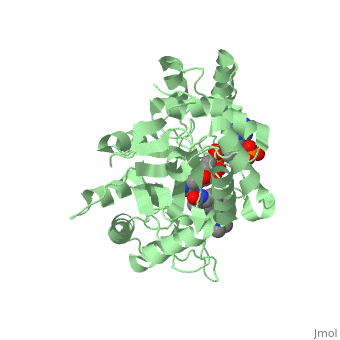Sandbox 45673
From Proteopedia
| Line 15: | Line 15: | ||
Finasteride is a 5-alpha reductase inhibitor. There are two isoforms of the 5alpha-reductase enzyme, type I and II, and while the drug has a higher affinity for the type II enzyme, it also inhibits the function of the type I. (Schieck,1998.) | Finasteride is a 5-alpha reductase inhibitor. There are two isoforms of the 5alpha-reductase enzyme, type I and II, and while the drug has a higher affinity for the type II enzyme, it also inhibits the function of the type I. (Schieck,1998.) | ||
Typically 5α-redcutase turns testosterone into Dihydrotestosterone(DHT), but the enzyme will accept Finasteride as an alternate substrate; turning it into dihydrofinasteride through an enzyme bound, NADP-dihydrofinasteride adduct. Finasteride is similar in structure to testosterone and 5alpha-reductase has almost the same affinity for both molecules. However, Finasteride , having a high affinity for 5α-reductase, covalently binds to the enzyme as a Michael acceptor, through a functionally irreversible reaction. However, the NADP-dihydrofinasteride complex breaks down with a half life of about 1 month at 37˚C., which is why patients must continue taking the drug.(Bull ''et. al,1995'') | Typically 5α-redcutase turns testosterone into Dihydrotestosterone(DHT), but the enzyme will accept Finasteride as an alternate substrate; turning it into dihydrofinasteride through an enzyme bound, NADP-dihydrofinasteride adduct. Finasteride is similar in structure to testosterone and 5alpha-reductase has almost the same affinity for both molecules. However, Finasteride , having a high affinity for 5α-reductase, covalently binds to the enzyme as a Michael acceptor, through a functionally irreversible reaction. However, the NADP-dihydrofinasteride complex breaks down with a half life of about 1 month at 37˚C., which is why patients must continue taking the drug.(Bull ''et. al,1995'') | ||
| + | |||
[[Image: Biochem group project.PNG]] | [[Image: Biochem group project.PNG]] | ||
| + | |||
==Medical== | ==Medical== | ||
Finasteride is used to shrink an enlarged prostate, also known as benign prostatic hyperplasia (BPH), in adult men (Allen, 2015). Enlarged prostate is located near the bladder which causes difficulty with passing urine. Common symptoms include, long period of time before urine flow, feeling the bladder is not empty, and dribbling urine (Allen, 2015). This medication works by blocking the enzyme 5α-reductase, which prevents conversion of testosterone to the natural body hormone, dihydrosestosterone (DHT) that causes growth of the prostate. As a result, reducing the amount of dihydrotestosterone causes the prostate to shrink. Thus, helps the urine pass easily. *I plan to add hyperlinks* | Finasteride is used to shrink an enlarged prostate, also known as benign prostatic hyperplasia (BPH), in adult men (Allen, 2015). Enlarged prostate is located near the bladder which causes difficulty with passing urine. Common symptoms include, long period of time before urine flow, feeling the bladder is not empty, and dribbling urine (Allen, 2015). This medication works by blocking the enzyme 5α-reductase, which prevents conversion of testosterone to the natural body hormone, dihydrosestosterone (DHT) that causes growth of the prostate. As a result, reducing the amount of dihydrotestosterone causes the prostate to shrink. Thus, helps the urine pass easily. *I plan to add hyperlinks* | ||
Revision as of 23:17, 5 December 2016
N-(1,1-dimethylethyl)-3-oxo-(5α,17β)-4-azaandrost-1-ene-17-carboxamide
| |||||||||||
References
- ↑ 1.0 1.1 I.K. Morton; Judith M. Hall (6 December 2012). Concise Dictionary of Pharmacological Agents: Properties and Synonyms. Springer Science & Business Media. pp. 121, 246. ISBN 978-94-011-4439-1
- ↑ 2.0 2.1 Yamana K, Labrie F, Luu-The V (January 2010). Human type 3 5α-reductase is expressed in peripheral tissues at higher levels than types 1 and 2 and its activity is potently inhibited by finasteride and dutasteride. Hormone Molecular Biology and Clinical Investigation. 2 (3). doi:10.1515/hmbci.2010.035
- ↑ Varothai, S; Bergfeld, WF (Jul 2014). "Androgenetic alopecia: an evidence-based treatment update.". American journal of clinical dermatology. 15 (3): 217–30. doi:10.1007/s40257-014-0077-5. PMID 24848508
Allen, Helen. (2015, March). "Finasteride for prostate gland enlargement. Information. Patient.
Bull, Herbert G.*Garcia-Calvo,Margarita Andersson,Stefan†, Baginsky, Walter F.,Chan,H. Karen,Ellsworth,‡ Dina E., Miller,§ Randall R., Stearns,Ralph A.,Bakshi,Raman K.,Rasmusson, Gary H.,Tolman,Richard L., Myers,Robert W.,Kozarich,John W.,Harris,Georgianna S. (1995, August 6) Mechanism-Based Inhibition of Human Steroid 5R-Reductase by Finasteride: Enzyme-Catalyzed Formation of NADP-Dihydrofinasteride, a Potent Bisubstrate Analog Inhibitor. http://pubs.acs.org/doi/pdf/10.1021/ja953069t
Leyden, J., Dunlap, F., & Miller, B., et el. (1999, June). Finasteride in the treatment of men with frontal male pattern hair loss.
Olsen, E. A., Hordinsky, M., & Whiting, D., et al. (2006, December). The importance of dual 5α-reductase inhibition in the treatment of male pattern hair loss: Results of a randomized placebo-controlled study of dutasteride versus finasteride.
Schieck, Cynthia L.(1998, August) "Finasteride (Propecia ®)". http://www.chm.bris.ac.uk/motm/finasteride/Finasteride%20(Propecia)%20-%20Feature%20Molecule.htm


